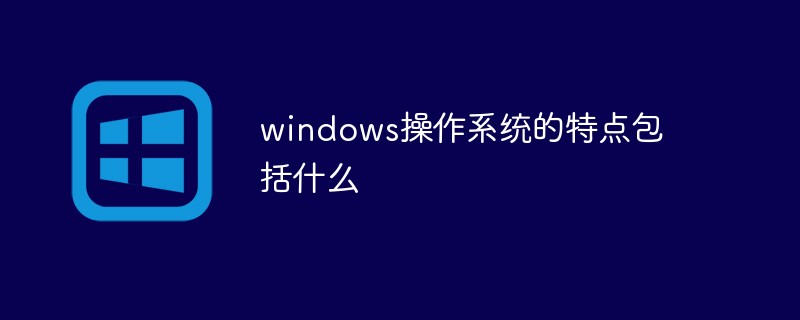
The features of the windows operating system include: 1. Graphical interface; intuitive and efficient object-oriented graphical user interface, easy to learn and use. 2. Multitasking; allows users to run multiple applications at the same time, or do several things at the same time in one program. 3. Plug and play. 4. Excellent multimedia functions. 5. Automatic management of memory.

The operating environment of this tutorial: Windows 7 system, Dell G3 computer.
Microsoft Windows operating system is an operating system developed by Microsoft Corporation in the United States. It came out in 1985. At first, it was just a Microsoft-DOS simulation environment. Subsequent system versions are not only easy to use due to continuous updates and upgrades by Microsoft. , has also become the most widely used operating system currently.
Windows adopts a graphical mode GUI, which is more user-friendly than the previous Dos method that required inputting commands. As computer hardware and software continue to upgrade, Microsoft's Windows is also constantly upgrading, from 16-bit to 32-bit to 64-bit architecture. The system version has changed from the original Windows 1.0 to the well-known Windows 95, Windows 98, and Windows 2000. , Windows XP, Windows Vista, Windows 7, Windows 8, Windows 8.1, Windows 10 and Windows Server server enterprise operating systems, Microsoft has been committed to the development and improvement of Windows operating systems
windows operation Features of the system
1. Intuitive and efficient object-oriented graphical user interface, easy to learn and use
The Windows user interface and development environment are both object-oriented. Users work in the manner of "selecting objects-operating objects". For example, to open a document, we first select the document with the mouse or keyboard, and then select the "Open" operation from the right-click menu to open the document. This mode of operation simulates real-world behavior and is easy to understand, learn and use.
2. Unified user interface
Most Windows applications comply with the CUA (Common User Access) standard proposed by IBM. All programs have the same or similar basic appearance, including windows and menus. , toolbar, etc. As long as users master one of them, it is not difficult to learn other software, thus reducing the cost of user training and learning.
3. Rich device-independent graphics operations--plug and play
The Graphics Device Interface (GDI) of Windows provides a rich set of graphics operation functions that can draw lines, circles, etc. , boxes, etc., and supports various output devices.
Device independence means that graphics with the same effect can be displayed on dot matrix printers and high-resolution monitors.
Device independence means that when you buy a new device, you don't have to consider whether a specific application software supports the device, as long as Windows supports it.
Windows supports the so-called "plug and play" function. It has included hundreds of device drivers. Whenever a new peripheral is added to the system and the connection is made on the hardware, the system can be started again. The device will be automatically checked out and the user will be guided through a dialog box to complete the driver installation.
4. Multitasking
Windows is a multitasking operating environment, which allows users to run multiple applications at the same time, or do several things at the same time in one program. Each program occupies a rectangular area on the screen. This area is called a window. Windows can overlap.
Users can move these windows or switch between different applications, and can perform manual and automatic data exchange and communication between programs. Although the computer can run multiple applications at the same time, only one is active and its title bar is highlighted. An active program is one that is currently capable of receiving user keyboard input.
5. Excellent multimedia functions
In Windows, you can complete all the command functions of the DOS operating system, and it is easier and more convenient. In addition, using WindOws can also complete many functions that cannot be achieved by the DOS operating system.
6. Break through the DOS64KB memory limit.
Windows implements automated management of memory, allowing large programs to run freely.
The above is the detailed content of What are the characteristics of windows operating system?. For more information, please follow other related articles on the PHP Chinese website!